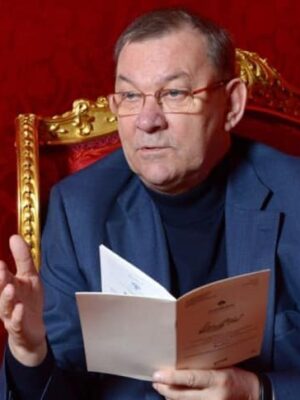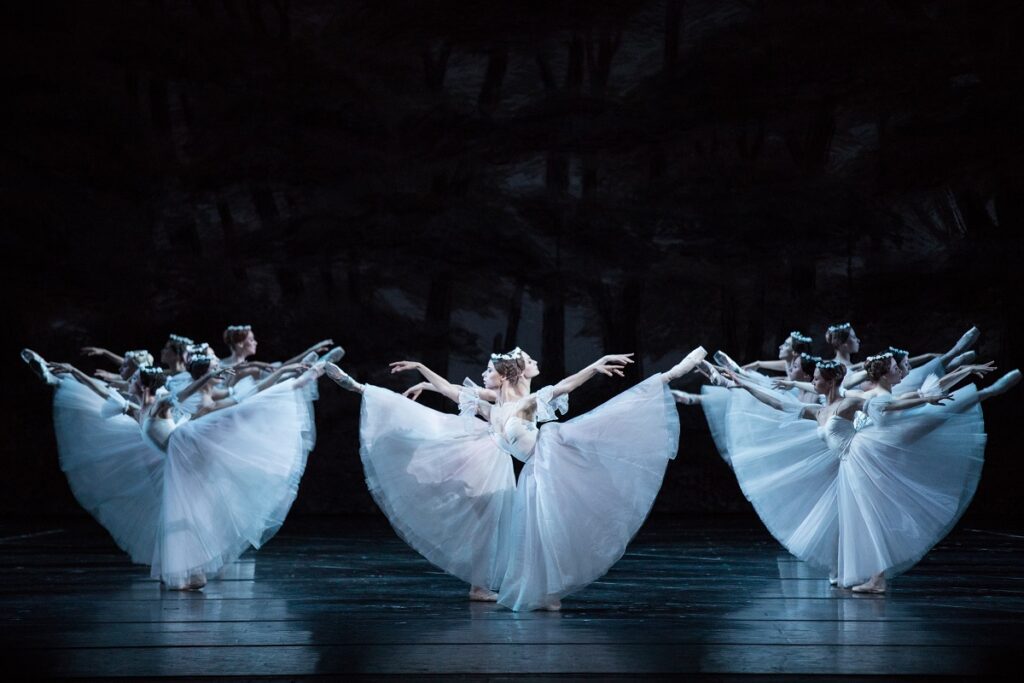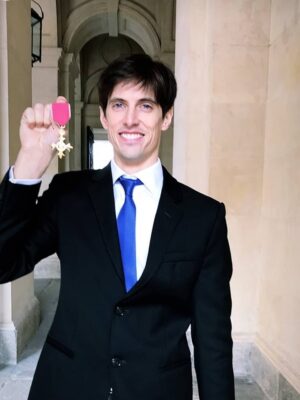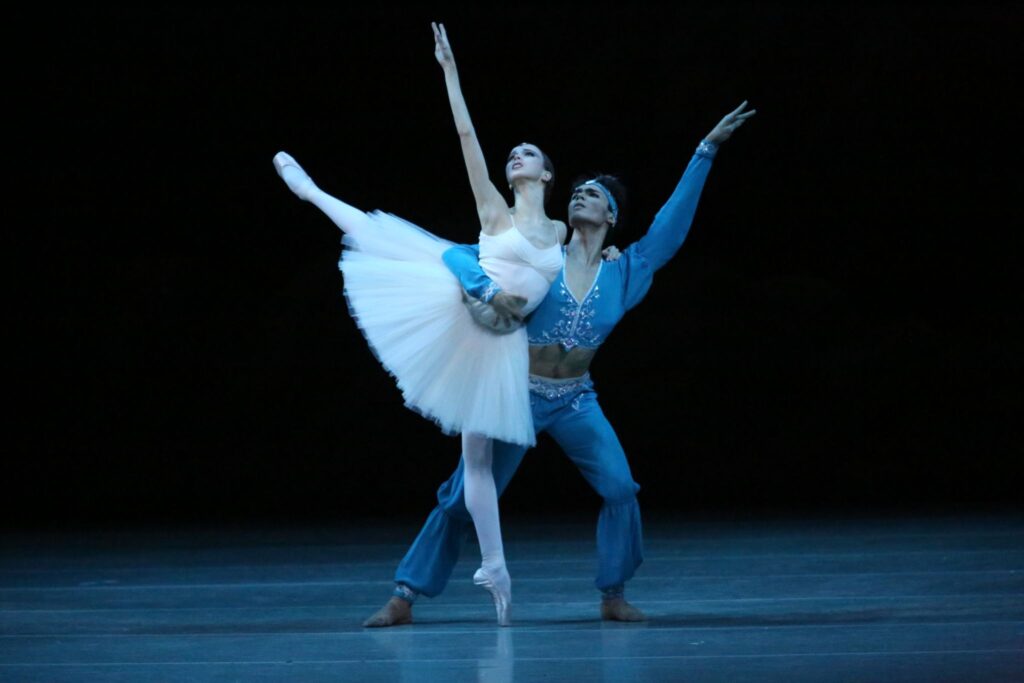
Despite the vast advances in ballet technique and performing prowess, it’s rare these days to really feel energy from artists on stage who, increasingly, may focus on steps at the expense of artistry. But in Saint Petersburg, the double debut of Maria Iliushkina and Victor Caixeta in Bayadere in late November far surpassed anything that has run on the famous Mariinsky stage in recent years. From Iliushkina’s reserved, noble pure-heartedness to Caixeta’s uncontainable passion –and later irrepressible grief– all three hours of the performance drew the audience into a world far from Covid, masks and QR codes, reminding us how precious human feelings can be.
Join Vaganova Today for it’s first-ever video interview with one of the Mariinsky’s youngest stars, Victor Caixeta, who hails from Brazil, trained in Germany, and is now in his 5th year with the company. Victor is a second soloist, but has a huge following both locally and internationally, and above all, is a humble, kind-hearted gentleman. Victor was the last pupil that world-famous pedagogue Gennady Silutsky worked with prior to the latter’s unexpected death in the autumn of 2020. We include here clips of Victor working with Silutsky to give you an idea of the energy and dedication both of these individuals bring to their art form. We hope you enjoy watching the interview as much as we enjoyed creating it with him!
If you like this video, please let us know. Subscribe to our YouTube channel “Vaganova Today” and our Facebook page by the same name. Help us survive by becoming a Patron:click the title, “Interview with Victor Caixeta” then click the red Patreon button on that page. Even a $5 donation will help! We appreciate your support!
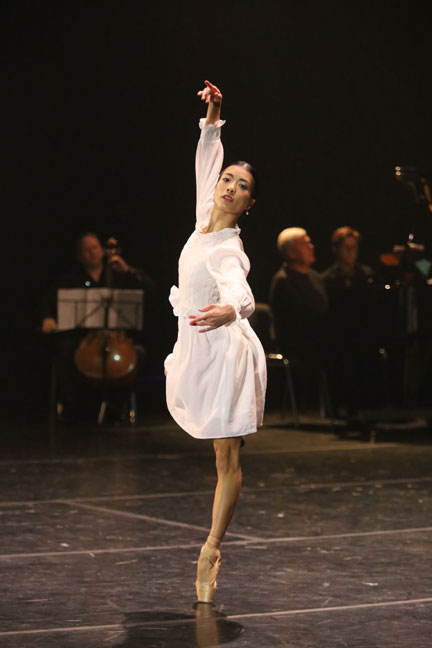 The Diaghilev PS festival, held every year in Russia for more than a decade and directed by Natalia Metelitsa, focuses on bringing contemporary choreography to the public, echoing the steps that famous impresario Sergey Diaghilev took when revealing ballet to the world at large.
The Diaghilev PS festival, held every year in Russia for more than a decade and directed by Natalia Metelitsa, focuses on bringing contemporary choreography to the public, echoing the steps that famous impresario Sergey Diaghilev took when revealing ballet to the world at large.
This year the festival’s Petersburg debut, held on November 4th, featured a full evening honouring the famous Russian composer Leonid Desyatnikov under the clever moniker “L.A.D” (the composer’s initials). Desyatnikov, hailed for being an “elegant, ironic, Petersburger” and known for his “ability to surprise” in the words of Metelitsa, alludes to numerous classical scores in many of his musical creations, where themes from Tchaikovsky or Saint-Saens suddenly creeping in, only to disappear among a flourish of other unique notes.
For those who may recall, Alexei Miroshnichenko, former artistic director of the Perm Ballet Theatre and prior to that, balletmaster at the Mariinsky, first introduced the balletgoing public to Desyatnikov’s music when he choreographed a pair of ballets to his scores:
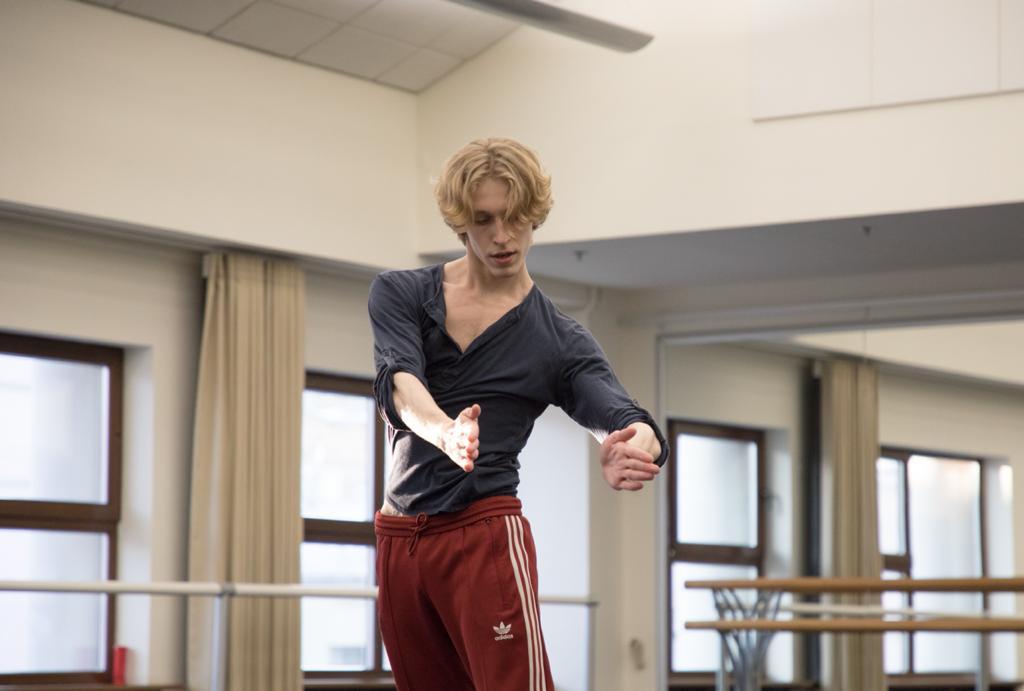 It seems that true choreographers are born, and not made. At least that’s the case for Maxim Sevagin, now in his sixth season as a soloist with the Stanislavsky Ballet, but with more than ten years’ experience creating choreographic works for various companies. His name is already known well in Russia, and it’s just a matter of time before the West figures out he is one of the most promising young choreographers. Vaganova Today has been tracking his career since his graduation from the Vaganova Academy in 2015, and sat down with him to discuss his career thus far.
It seems that true choreographers are born, and not made. At least that’s the case for Maxim Sevagin, now in his sixth season as a soloist with the Stanislavsky Ballet, but with more than ten years’ experience creating choreographic works for various companies. His name is already known well in Russia, and it’s just a matter of time before the West figures out he is one of the most promising young choreographers. Vaganova Today has been tracking his career since his graduation from the Vaganova Academy in 2015, and sat down with him to discuss his career thus far.
You were not born in Saint Petersburg, but in a small city, Rubtsovsk, in Siberia. What caused you to move to Saint Petersburg?
At age 4, I saw some dancers from a local studio performing on the street for a city holiday. I asked my mom to take me to classes, but I never knew what ballet was. Then, when I was about 10, I told her I wanted to dance professionally and receive dance training education. She started to think about what to do because in the provinces where we were located, far from the capital, you might say people aren’t as cultured and don’t know much about ballet. Through my friends, my mother found out about the Novosibirsk Choreographic College and I joined it and spent 1 year there.
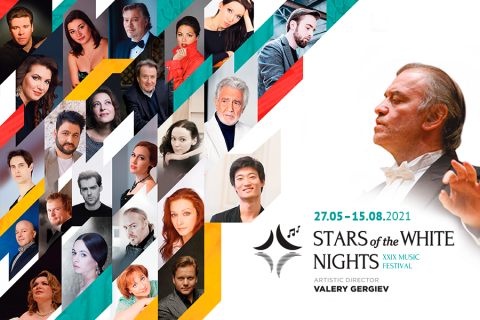 Despite the second year of the Covid pandemic as of this March, Russian theatres continued to work at full throttle throughout the past year. In Saint Petersburg, July brought the close of the annual White Night’s festival as well as the premieres of choreographer Max Petrov’s Renard, The Moor, and The Fairy’s Kiss — three works set to Stravinsky, the second of which is opera.
Despite the second year of the Covid pandemic as of this March, Russian theatres continued to work at full throttle throughout the past year. In Saint Petersburg, July brought the close of the annual White Night’s festival as well as the premieres of choreographer Max Petrov’s Renard, The Moor, and The Fairy’s Kiss — three works set to Stravinsky, the second of which is opera.A triptych of jubilee Artistic Evenings was presented in July as well: Viktoria Tereshkina (July 3) and Ekaterina Kondaurova (July 6) each celebrated 20 years on stage, while Kimin Kim (July 18) marked his 10th anniversary with the Mariinsky. A gala concert was also held (July 8) in honour of famed pedagogue Ludmila Kovalyova, who has cultivated many ballet careers in Russia, among them Olga Smirnova and Diana Vishneva.
Mariinsky White Nights Festival
This year’s “White Nights” festival begins on June 2nd with a series of back-to-back performances throughout the month that include Swan Lake by the Jakobson Ballet Theatre, and on June 10, 13 and 14, the Vaganova Academy annual graduation performances. Currently, Alexei Ratmansky is setting The Pharoah’s Daughter on the troupe, with a premiere set for December 2021.
Bolshoi Theatre
The Bolshoi held a press conference in May, announcing it’s 2021-22 season plans. Alexei Ratmansky will present “The Art of Fugue” in April 2022 set to music by Johann Sebastian Bach. July 2022 will bring three other new ballet premieres, rescheduled from the initial plans for 2020. Vyacheslav Samodurov’s “DanceMania” will appear on a bill along with Anton Pimonov’s “Made in Bolshoi” and principal dancer Artemy Belyakov’s debut work “Russian Seasons”.
Tragic News
On May 12, Mariinsky Ballet soloist David Zaleyev fell off of an electric scooter without a helmet, hit his head on the sidewalk pavement, and was immediately both immobile and unconscious. Two passersby as well as a semi truck stopped to attend to him, and he was taken to the hospital where it was determined he had experienced brain injuries, and was placed in a medicated coma (presumably to stop swelling). On around May 19th or 20th he was transferred to the Polenov Neurosurgery Research Institute in Petersburg, still in a coma. His chances, as the articles claim, are 50/50. We are praying for David, and hope for a miraculous and early recovery, and that he may dance again.
Mariinsky Ballet Prima Ballerina Daria Pavlenko made a difficult decision three years ago. She chose to retire officially from the Mariinsky Ballet troupe although she had the right to remain longer. While other primas have remained on roster for five, ten, or more years after the accepted retirement age of 38, performing rarely or not at all yet still receiving pay, Pavlenko decided to move on to other pursuits. She performed Alexei Ratmansky’s “Anna Karenina” for her final performance in July 2018 and immediately enrolled in the Rimsky Korsakov Conservatory to study pedagogy. With her plate full of various endeavors now, she continues to develop her stage career in a new direction, while tending to her family full time as well.
Untainted by the elitism that plagues many international stars, Daria Pavlenko’s honest approach to her art form emerges just as easily in conversation as it does in all of her onstage roles. VaganovaToday sat down with her to find out about her life as a dancer, teacher, mother and wife.
After a short break for the New Year’s holidays — January 1st to 6th were holidays for the Mariinsky and just Jan. 1st for the Bolshoi — Russian theatres slowly resumed their full performance schedule in early 2021 with the 50% capacity rule in most places.*
With the rollout of the Sputnik V this year, increasing numbers of citizens and visitors have been receiving the vaccine against the coronavirus, which will hopefully slow the spread and ease the country back to normalcy.
January and February passed without any notable premieres at the top 2 theatres except for the repeat of last September’s Bolshoi programme, “Four Characters in Search of a Plot”.
March promises some excitement though, when the Bolshoi will premiere “Orlando”, if all goes as planned, on March 24th. The work by Christian Shpuck, currently the head of Ballet Zurich in Switzerland, is based on Virginia Wolfe’s novel about a creature who travels across 350 years of time, changing from male to female along the way. Created and rehearsed during the pandemic, it will premiere on the Bolshoi’s new stage.
Meanwhile, word has it that the Mariinsky Festival will resume this April, which would be great news indeed, since last year’s was interrupted by the start of the pandemic and a national lockdown. But without the ability to import foreign dancers, which is usually the focus of the festival, it remains to be seen what might be presented.
*At the Bolshoi, the upper balconies and box seats are closed permanently and tickets to those seats are not sold. Instead the orchestra seats are sold in a checkerboard pattern, but people re-seat themselves (next to each other) and masks and social distancing are perfunctory measures to get through the door, at best.
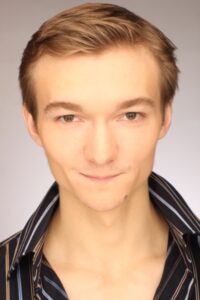 Holding the prestigious position of first soloist with the Mariinsky, Alexander Sergeev is much more than one of the most praised dancers in Russia. He has long been dancing principal roles, and popular opinion suggests he should in fact hold principal status. Sergeev has already created several compelling ballets that have been performed at the Mariinsky’s annual festivals, and he has been pursuing a side business as a concert producer with significant success.
Holding the prestigious position of first soloist with the Mariinsky, Alexander Sergeev is much more than one of the most praised dancers in Russia. He has long been dancing principal roles, and popular opinion suggests he should in fact hold principal status. Sergeev has already created several compelling ballets that have been performed at the Mariinsky’s annual festivals, and he has been pursuing a side business as a concert producer with significant success.
Vaganova Today sat down with him to find out more about his career and aspirations.
* * *
 23 December 1937 – 29 October 2020
23 December 1937 – 29 October 2020
It is with a very heavy heart that I share the sad news of the passing, yesterday, of the Mariinsky’s greatest male pedagogue, Gennady Seliutsky. Known for his character roles on stage and moreso for a sparkling career honing the talents of the Mariinsky’s top male dancers. While I never worked as closely with him as his dancers did, I had the honour of interviewing him several times, and ever since then, whenever we crossed paths, his warm smile and demeanour always welcomed me with a short chat. I know how devastated the dancers are today, and my own tears fall as I share their grief. Rest in peace dear Gennady Naumovich, you will be greatly missed, always remembered, and never replaced.
“What is ballet? the art of ballet? It is music that you see and feel.” – Gennady Seliutsky
Russia’s leading ballet theatres have much in store for the second half of the 2019-2020 season, which for most will run through July 2020.
At the Bolshoi, former Mariinsky dancer and now choreographer Anton Pimonov will present a new work, “Made at Bolshoi” on 26 March as part of a mixed bill that includes Vyacheslav Samodurov’s “Tanzmania” and principal Bolshoi dancer Artemy Belyakov’s “Vremeni Goda” (The Seasons). On 21 May, the theatre will premiere the new “Master and Margarita” by Edward Klug, who presented his version of “Petrushka” on last year’s mixed bill alongside Forsythe’s “Artefact Suite”.
The Mariinsky’s annual International Ballet Festival begins on 11 March with a heavy focus on Ratmansky. The festival opens with an evening of Ratmansky’s ballets, and will also present his “Seven Sonatas” for the first time, which is being set on site by Stella Abrera (American Ballet Theatre). If the coronavirus does not cause cancellations, then several guest stars are slated to appear. Lauren Cuthberthson, who fell ill before she was able to perform “The Sleeping Beauty” in last year’s festival, will make another go of it this year alongside Xander Parish. Oksana Skorik will join the Paris Opera Ballet’s Germain Louve for “Swan “Lake”, and the Bolshoi’s Olga Smirnova is set to appear in “Giselle.” In addition, the Bolshoi’s Vladislav Lantratov and Maria Alexandrova will appear at both the opening and the closing of the festival.
The international pandemic of the coronavirus has altered the landscape of the world’s ballet stages, both big and small, for the foreseeable and perhaps even not so foreseeable future. In Russia, all state theatres (Mariinsky, Bolshoi, Perm, Stanislavsky, Mikhailovsky, etc.) closed on March 17th with initial plans that the closure would be lifted in early April. The closure was extended until late April subsequently. Then, on 9 April, General Director of the Bolshoi Vladimir Urin told Kommersant that he felt a reopening in September 2020 for the fall season was “optimistic” at best. Implying that there was a good chance the state theatres’ closure would continue for the rest of this calendar year. While foreign theatres have short spring seasons (ABT and SFB both have just a few months of performances), the Russian season runs daily through late July in all theatres and starts again in September with more performances immediately. Losses at the Bolshoi per day of missed performances, amount to millions of rubles. And then of course there is the dancers’ physical health to take into consideration when they are off for half of a year or more.
Here is to hoping, that optimistically, we might see some ballet in Russia before the end of 2020. Stay healthy everyone.
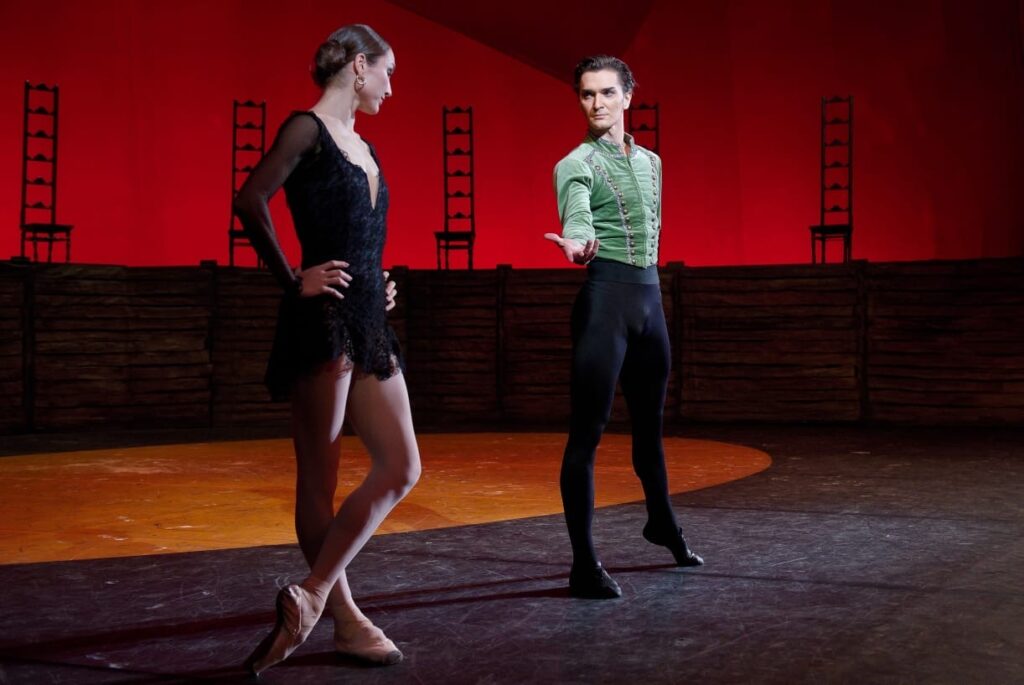 It was the 4th of April 2019, the premiere of A Winter’s Tale and the Bolshoi Theatre was full. A double tour en l’air moving stage left. A step he had done thousands of times since his school days. But something went wrong – the angle of the landing or the torque, maybe simply overwork. No sooner had both legs hit the ground than he immediately lifted one off the floor, and hopped into the wing on the other. The music stopped. The curtain came down. A murmur filled the house and the house lights came on for an unplanned intermission.
It was the 4th of April 2019, the premiere of A Winter’s Tale and the Bolshoi Theatre was full. A double tour en l’air moving stage left. A step he had done thousands of times since his school days. But something went wrong – the angle of the landing or the torque, maybe simply overwork. No sooner had both legs hit the ground than he immediately lifted one off the floor, and hopped into the wing on the other. The music stopped. The curtain came down. A murmur filled the house and the house lights came on for an unplanned intermission.
One might refer to the year 2019 as the season of Giselles in Moscow. Under Laurent Hilaire’s artistic directorship, the Stanislavsky is mounting a series of classical ballets based on either Hilaire’s vision or Nureyev’s versions set at the Paris Opera Ballet. This July, Hilaire’s Giselle premiered (Nureyev’s version of Don Quixote will follow in late October). The Bolshoi Ballet, not to be outdone, will counter with Alexei Ratmansky’s new version of Giselle this November. But the Stanislavsky version came first and is an integral part of the increasingly popular company’s repertoire.
 From 21 to 24 November, the Bolshoi Theatre presented Alexei Ratmansky’s latest masterpiece, a momentous reconstruction of Giselle, infused with new choreographic alterations and several key departures from the currently known libretto. The revised version culls information from the Stepanov notation, Henri Justamen’s records and at least 4 other sources. Robert Perdziola’s enchanted set designs, based on originals by Alexander Benois, take us immediately to a medieval time and place in which social classes may obstruct true love, and legends of evil spirits literally come to life. Ratmansky’s choreographic shifts highlight the libretto’s underlying theme of Christianity throughout the work, lending a deeper meaning to this ballet and marking its historical significance.
From 21 to 24 November, the Bolshoi Theatre presented Alexei Ratmansky’s latest masterpiece, a momentous reconstruction of Giselle, infused with new choreographic alterations and several key departures from the currently known libretto. The revised version culls information from the Stepanov notation, Henri Justamen’s records and at least 4 other sources. Robert Perdziola’s enchanted set designs, based on originals by Alexander Benois, take us immediately to a medieval time and place in which social classes may obstruct true love, and legends of evil spirits literally come to life. Ratmansky’s choreographic shifts highlight the libretto’s underlying theme of Christianity throughout the work, lending a deeper meaning to this ballet and marking its historical significance.
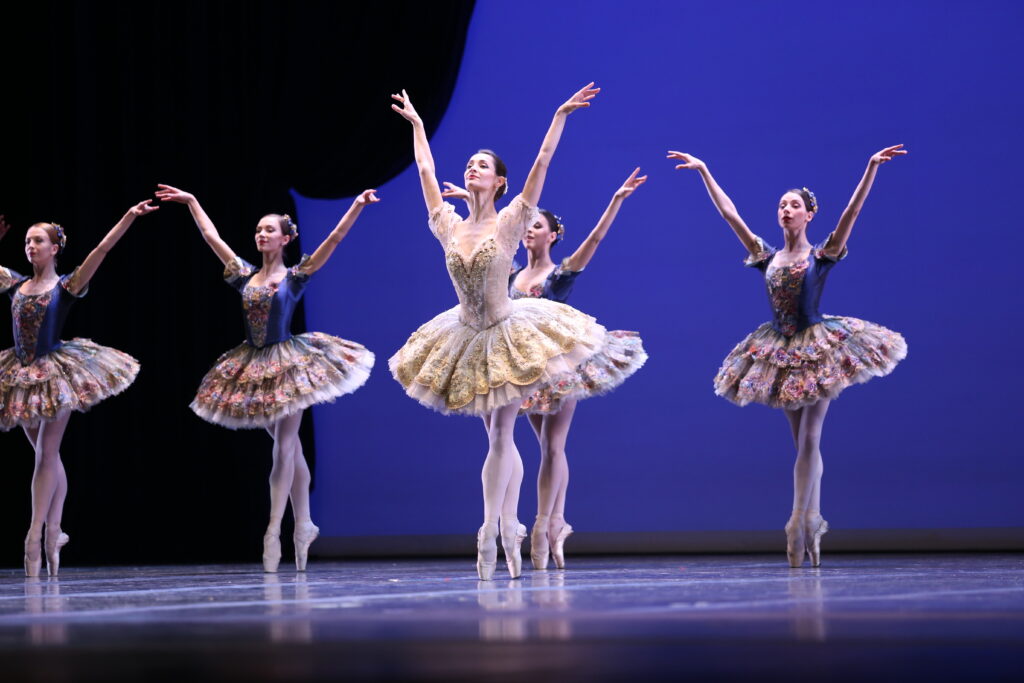 To mark the Stanislavsky Nemirovich-Danchenko Theatre’s 100th anniversary, Artistic Director Laurent Hilaire created a gala concert featuring a new choreographic work and international guest stars. On July 29th and 30th, all of Moscow clamoured to attend the two-night extravaganza which featured the best this Moscow troupe has to offer.
To mark the Stanislavsky Nemirovich-Danchenko Theatre’s 100th anniversary, Artistic Director Laurent Hilaire created a gala concert featuring a new choreographic work and international guest stars. On July 29th and 30th, all of Moscow clamoured to attend the two-night extravaganza which featured the best this Moscow troupe has to offer.
In unusual fashion, the highlight of the evening in fact came first. Choreographic talent Maxim Sevagin, a Vaganova graduate who displayed his ability to set classical ballets even as a student, and set works for the Mariinsky’s choreographer’s workshop in 2014 and 2015. Since joining the Stanislavsky in 2016, he has continued to create, refining his art in both more avant-garde and neoclassical genres.
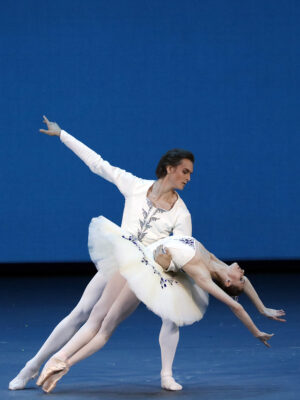 The scandals at the Bolshoi Theatre over the past decade have given the theatre a name synonymous with disgrace. The acid attack on Sergey Filin, Nikolai Tsiskaridze’s sharp criticisms of the renovation process, the advent of a new administration and the changing of the guard (and some of the troupe’s members) as a result.
The scandals at the Bolshoi Theatre over the past decade have given the theatre a name synonymous with disgrace. The acid attack on Sergey Filin, Nikolai Tsiskaridze’s sharp criticisms of the renovation process, the advent of a new administration and the changing of the guard (and some of the troupe’s members) as a result.
Mr. Xander Parish, principal dancer with the Mariinsky who hails from Yorkshire, United Kingdom, just received an award at Buckingham Palace, “Officer of the Order of the British Empire” from His Royal Highness the Prince of Wales for cultural contributions. Parish has been with the Mariinsky since 2010.
Congratulations, and very well deserved sir.

